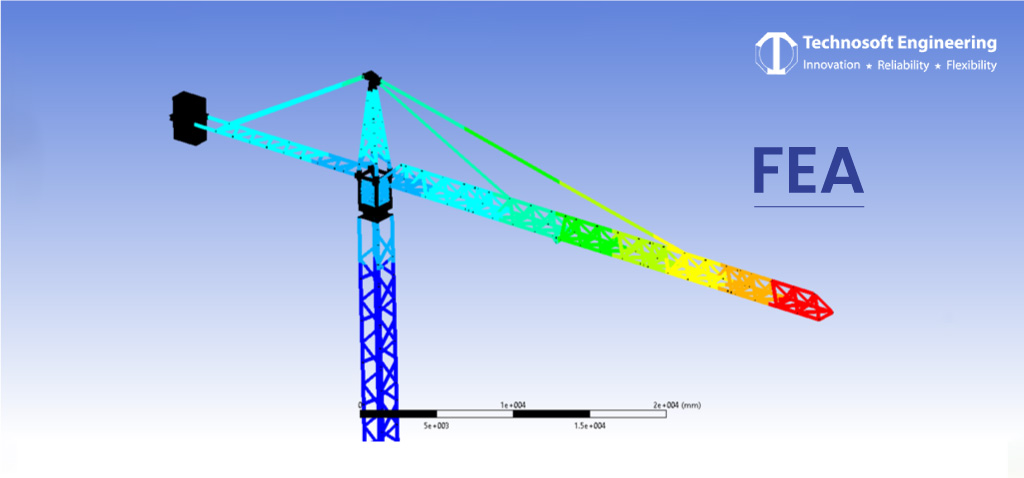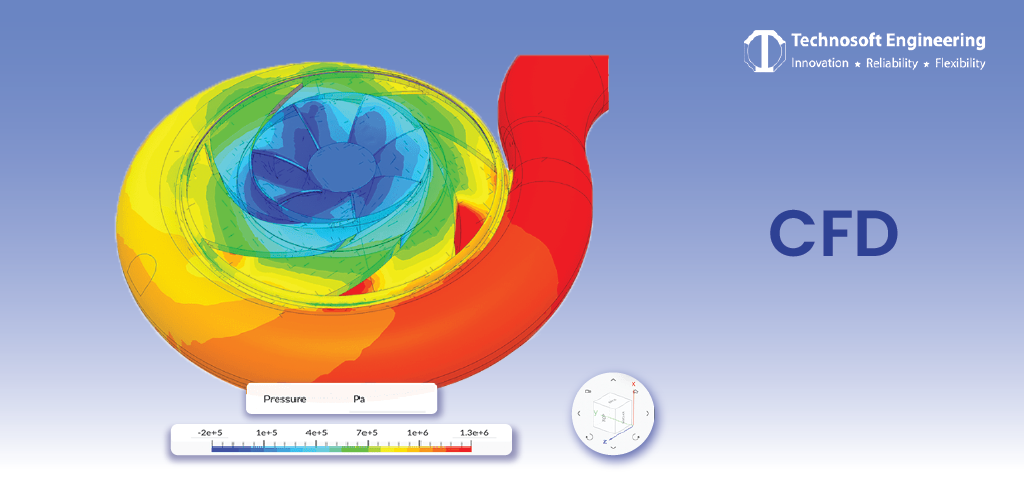
Key Takeaways
In engineering design and analysis, Finite Element Analysis (FEA) and Computational Fluid Dynamics (CFD) are critical tools that enable engineers to optimize design, improve performance, and gain speed in product development. This exhaustive guide discusses the intricacies involved in leveraging FEA and CFD within CAD/CAM projects, outlining their capabilities, advantages, and challenges for Technosoft Engineering’s expertise.
Table of Content
- What is FEA ?
- What is CFD ?
- When to Use FEA?
- When to use CFD?
- Combustion Simulation
- How To Choose Between FEA And CFD?
- FEA vs. CFD: Key Differences and Applications
- What are the benefits and challenges of FEA and CFD?
- The Unsung Hero – FEA and CFD
- Leverage Technosoft’s FEA and CFD engineering simulation services for faster, more reliable product development
- Technosoft’s engineering simulation services in FEA and CFD are helpful for
Introduction
Engineers are often under pressure from industries that change rapidly to create products with improved performance requirements. Hence the quest for engineering excellence often requires advanced simulation techniques such as FEA and CFD.
While the former enables evaluation of structural integrity, stress distribution, thermal behavior and vibration characteristics of components/systems; the latter deals with fluid dynamics, heat transfer, aerodynamics and flow optimization.
These simulation methodologies integrated within Computer Aided Engineering in CAD/CAM workflows open up new paths for design innovation, predictive analysis as well as performance optimization.
What is FEA ?
FEA (Finite Element Analysis) refers to a numerical technique that is used for analyzing the behavior of structures and components under different mechanical-thermal-electromagnetic loads, complex geometries being discretized into finite elements so as to allow detailed examination of stresses/strains/deformations/performance indicators.
It comes into play in validating designs, optimizing material usage patterns, predicting failure modes or conducting virtual tests before physical prototypes making it an important aspect of any engineering process.
FEA involves several analyses which comprises of:
-
Structural Analysis:
Test’s structural integrity as well as load bearing capacity safety factors.
-
Thermal Analysis:
Examine heat transfer including thermal gradients at thermal management strategies.
-
Fatigue Analysis:
Predicts component fatigue life including durability plus reliability when cyclically loaded.
-
Vibration Analysis:
Investigates natural frequencies vs resonance which relates damping along with structural response towards vibrations.
Our FEA simulations utilize cutting-edge software and methodologies for accurate results, informed design decisions, and improved performance across a variety of engineering disciplines.
What is CFD ?
CFD (Computational Fluid Dynamics) involves the simulation technique used to observe fluid flow processes involving heat transfer as well as mass transport in fluid systems. It uses computational algorithms solving Navier-Stokes equations capturing fluid behavior turbulence effects pressure gradients velocity distribution within complex geometries.
CFD helps engineers optimize fluid dynamics for aerodynamics, HVAC system design, analysis of combustion and environmental impact assessments.
Technosoft Engineering’s CFD capabilities involve range of analyses which include:
-
Fluid Flow Analysis:
Understanding behavior of fluids, pipe lines with their system pressure drop.
-
Aerodynamics Simulation:
Investigating airflow over vehicles such as aircrafts, wind turbines or just other aerodynamic surfaces.
-
Heat Transfer Analysis:
Assessing thermal gradients together with heat dissipation under thermal performance in systems.
-
HVAC System Design:
Creating energy-efficient heating, ventilation and air conditioning systems.
-
Combustion Analysis:
Simulating combustion processes; fuel-air mixing plus emissions control strategies.
Our CFD simulations incorporate advanced turbulence models multi-phase flow analysis transient simulations resulting in complete understanding of fluid dynamics and thermal behavior.
When to Use FEA?
FEA finds application in various scenarios including:
-
Structural Analysis:
Evaluating static or dynamic loads material characteristics component performance
-
Design Optimization:
Tailoring designs iteratively through weight reduction enhanced stiffness durability improvement
-
Failure Prediction:
Spotting areas at risk fatigue prone zones stress concentration that may cause failure
-
Product Validation:
Comparing the designs against industry standards regulatory requirements besides performance criteria
-
Multi-Physics Simulation:
Offering holistic assessment through integration of thermal electromagnetic structural and fluid flow analyses.
FEA (Finite Element Analysis) simulations from Technosoft Engineering are helpful in taking design decisions, optimizing product performance and ensuring that the structures have appropriate strength for different applications.
When to use CFD?
CFD Applications across different domains include:
-
Fluid Dynamics Analysis:
It involves studying fluid behavior, velocity profiles, turbulence effects and flow characteristics
-
Thermal Management:
It includes analyzing heat transfer, thermal gradients and cooling strategies for electronic systems
-
Aerodynamic Performance:
Involves evaluating airflow, lift, drag and aerodynamic efficiency in aerospace and automotive designs
-
HVAC System Design:
Concerned with optimizing airflow distribution, temperature control and energy efficiency of HVAC systems.
-
Combustion Simulation:
It models combustion processes, fuel-air mixing, emission predictions and combustion chamber designs.
Technosoft Engineering’s CFD simulations help engineers to optimize fluid dynamics, improve thermal management and enhance system performance across various engineering disciplines.
How To Choose Between FEA And CFD?
The selection between FEA (Finite Element Analysis)and CFD often depends on specific engineering objectives as well as analysis goals by utilizing the following considerations:
| Feature | FEA (Finite Element Analysis) | CFD (Computational Fluid Dynamics) |
| Focus | Solid mechanics and structures (stress, strain, deformation, etc.) | Fluid flow and heat transfer (pressure, velocity, temperature, etc.) |
| Underlying Method | Finite Element Method (FEM): Divides the model into small elements | Various methods: Finite Volume Method (FVM), Finite Difference Method (FDM) |
| Strengths | Analyzing stresses, strains, and deformations in solids | Simulating fluid flow, heat transfer, and other fluid-related phenomena |
| Typical Applications | Analyzing bridges, buildings, machines, components under various loads | Simulating airflow around a car, blood flow in an artery, heat transfer in a heat sink |
| Choosing When | Design primarily involves solids and their structural behavior | Design primarily involves fluids and their flow or heat transfer |
| Additional Notes | FEA can be used for limited fluid flow problems with modifications, but CFD is generally more robust. May utilize FEM, but encompasses a broader range of methods. | Some CFD software might utilize the FEM technique, but CFD encompasses a broader range of methods. |
Technosoft Engineering also provides consultants and advisors to assist engineers in making choices, choosing the right simulation approach, and achieving good design.
FEA vs. CFD: Key Differences and Applications
Differentiating finite element analysis (FEA) from computational fluid dynamics (CFD) involves understanding their core principles, capabilities, and application domains:
FEA is focused on structural analysis, stress distribution, deformation behavior and mechanical response of components/systems. It is useful for evaluating static & dynamic loads, material properties and structural integrity in mechanical, civil, aerospace and automotive cases.
On the other hand CFD focuses on fluid flow analysis; heat transfer phenomena; aerodynamic performance as well as thermal behavior of fluids. For example it can be used to study airflow over surfaces; thermal management in electronics; aerodynamic design optimization as well as environmental fluid dynamics.
In addition Technosoft Engineering has expertise in FEA and CFD domains that allows offering comprehensive engineering simulation solutions specifically customized for different industry requirements or engineering challenges.
What are the benefits and challenges of FEA and CFD?
Benefits and Challenges of FEA and CFD:
Benefits of Finite Element Analysis (FEA):
-
Structural Integrity:
Evaluate structural integrity – strength capacity – safety factor.
-
Design Optimization:
Optimize designs for weight reduction or stiffness improvement or performance enhancement.
-
Failure Prediction:
Predict potential failure modes such as stress concentrations or fatigue-prone areas.
-
Material Selection:
Determine materials’ properties/behavior/suitability for specific applications.
-
Virtual Testing:
Perform virtual testing/validation/verification of designs before physical prototyping.
Challenges of Finite Element Analysis (FEA):
-
Complex Modeling:
Accurately model complex geometries, material properties and boundary conditions.
-
Computational Resources:
Use high computational resources to perform extensive simulations & analyses with fine details.
-
Validation & Calibration:
Validate FEA results against physical testing; calibrate models for accuracy purposes;
-
Meshing Challenges:
Address meshing issues like element distortion or convergence criteria thus ensuring accurate results.
-
Interpretation of Results:
Interpret and analyze FEA output data to derive actionable insights and design recommendations.
Benefits of Computational Fluid Dynamics (CFD):
-
Fluid Dynamics Analysis:
Study fluid behavior, flow patterns as well as pressure distribution in fluid systems.
-
Heat Transfer Optimization:
Optimize heat transfer, thermal management and cooling strategies for enhanced performance.
-
Aerodynamic Performance:
Enhance aerodynamic efficiency, decrease drag or improve vehicle/aircraft performance.
-
Environmental Impact Assessment:
Evaluate environmental fluid dynamics, pollutant dispersion and air quality modeling.
-
HVAC System Design:
Build efficient HVAC systems that optimize airflow distribution and improve indoor air quality.
Challenges of Computational Fluid Dynamics (CFD):
-
Complex Geometries:
Model accurately – complex geometries; boundary conditions or multiphase flows.
-
Turbulence Modeling:
Implement accurate turbulence models to resolve boundary layer effects and predict turbulence behavior
-
Transient Simulations:
Transient simulations, dynamic flow phenomena – time dependent behavior development.
-
Meshing and Grid Generation:
Generate high-quality meshes in order to resolve mesh dependency issues with grid convergence ensured.
-
Validation and Verification:
Validate CFD simulations against experimental data, benchmarks including empirical correlations for validation purposes
The Unsung Hero – FEA and CFD
Let me share a small story,
As a company pitched for a new engine design, two mechanical engineers bump fists with a satisfied grin. Their FEA simulations identified a critical stress point early, allowing them to optimize the design before physical prototypes. Meanwhile, the CFD simulations revealed an unexpected airflow pattern that led to more efficient cooling. They clink coffee mugs, toasting to the silent victories of FEA and CFD – the unsung heroes that helped them deliver a superior design without ever needing a single physical test run, saving time and cost to the company.
Leverage Technosoft’s FEA and CFD engineering simulation services for faster, more reliable product development.
Technosoft Engineering offers comprehensive engineering simulation services in the areas of FEA and CFD specifically tailored for different industry verticals such as automotive, aerospace, defense, electronics, healthcare or manufacturing. These include:
-
Advanced Finite Element Analysis (FEA):
Structural analysis,-thermal analysis,-fatigue analysis,-vibration analysis-and multi-physics simulations.
-
Computational Fluid Dynamics (CFD):
Fluid flow analysis,-heat transfer simulations,-aerodynamic optimizations,-HVAC system design-and combustion analysis.
-
Simulation-Based Design Optimization:
Iterative design refinement.-Parametric studies.-Optimization algorithms.-Performance-driven design enhancements.
-
Virtual Testing & Validation:
Virtual prototyping.-Physical testing validation.-Design verification.-Regulatory compliance assessments.
-
Customized Engineering Solutions:
Tailored simulation methodologies,-domain-specific expertise,-and innovative problem-solving approaches.
Technosoft’s engineering simulation services in FEA and CFD are helpful for:
-
Time-to-Market Acceleration:
Speed up the product development cycles, lessen design iterations and fast track design validation processes.
-
Improved Performance:
Enhance the efficiency of products, improve performance, reduce operational costs and achieve performance targets.
-
Design Thinking:
Promote innovative designs, probe alternate ideas, encourage iterative designs as well as drive better use of technology.
-
Cost Minimization:
Reduce costs for prototypes, avoid mistakes in designing stage, optimize material consumption, limit physical tests.
-
Regulatory Compliance:
Observe industry norms to adhere to regulatory regulations on safety and quality benchmarks.
In summary, a new approach to design optimization can be realized through efficient utilization of FEA and CFD within CAD/CAM schemes aimed at enhancing performance and engendering technological innovation.
Technosoft Engineering’s advanced modeling capabilities in combination with custom-designed solutions enable companies to overcome their engineering challenges that can assist them to excel in product development process in today’s dynamic world market.



